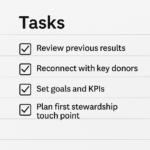KPIs: How to Set Fundraising Goals with Direct Reports

Practical Guide for Charity Leaders
Fundraising success doesn’t happen by accident—it’s the result of clear direction, measurable goals, and disciplined execution. One of the most effective tools for driving fundraising performance is the use of Key Performance Indicators (KPIs). But simply handing down KPIs from leadership can backfire. To build a high-performing team, managers must engage fundraisers in co-creating KPIs that are realistic, ambitious, and aligned with organisational goals. Here’s how to approach this, what pitfalls to avoid, and what to do when KPIs aren’t met.
Engaging Fundraisers in Setting Their KPIs
Goals should not feel like arbitrary numbers imposed from above—they should be developed through a collaborative process between manager and fundraiser. This approach fosters ownership, motivation, and accountability.
Best Practices:
- Start with the Organisational Target: Be transparent about the overall fundraising goal and how it breaks down by program (e.g., major gifts, regular giving, corporate partnerships).
- Review Historical Performance: Discuss past performance—what worked, what didn’t, and what reasonable stretch goals could look like.
- Tailor KPIs to Portfolio and Role: Fundraisers managing major gifts will have different metrics from those working in direct marketing or corporate giving. Set goals based on the maturity of their donor portfolio and pipeline health.
- Encourage Input: Ask the fundraiser to propose their targets within organisational expectations, then negotiate to ensure they’re both realistic and ambitious.
This collaborative method encourages commitment rather than compliance.
Common Pitfalls to Avoid
Setting goals is deceptively simple—but there are traps to avoid:
- Focusing Only on Activity Metrics: Meetings booked and calls made are meaningless if they don’t convert to revenue. Balance activity KPIs with outcome KPIs.
- Setting Unrealistic Stretch Goals: Overly ambitious targets demotivate rather than inspire. Goals should stretch people but still feel achievable.
- Ignoring Pipeline Variability: Not every portfolio is equally mature. A new fundraiser with a cold portfolio shouldn’t have the same KPIs as a seasoned team member.
- “Set and Forget” Mentality: KPIs should be revisited quarterly—not just set in January and ignored. Circumstances change, and flexibility is key.
What to Do When Fundraisers Miss KPIs
Missing KPIs is inevitable from time to time. The key is not to jump to conclusions but to diagnose and respond appropriately:
- Investigate the Why: Was it external (economic downturn)? Internal (lack of resources)? Or performance-related (not enough donor engagement)?
- Intervene Early: Regular check-ins and pipeline reviews can highlight issues before they become crises.
- Offer Support: Coaching, professional development, or adjusting portfolio composition might be necessary.
- Address Performance Gaps: If underperformance is persistent and within the fundraiser’s control, it may warrant a structured performance improvement plan.
The point is to respond thoughtfully—support where possible, hold accountable where necessary.
Examples of Typical Fundraising KPIs
A healthy KPI framework blends quantitative and qualitative targets:
- Revenue KPIs:
- Dollar value of gifts secured (annual, major, corporate)
- Year-over-year revenue growth
- Percentage of goal achieved
- Pipeline KPIs:
- Number of qualified prospects added to portfolio
- Number of solicitations/proposals submitted
- Pipeline value relative to goal (e.g., 3x annual target)
- Activity KPIs:
- Number of meaningful donor contacts per month
- Number of first-time donor visits
- Stewardship actions completed post-gift
- Retention KPIs:
- Donor retention rate year over year
- Percentage of lapsed donors re-engaged
The right mix depends on role, tenure, and portfolio type.
Well-set goals are the backbone of a performance-driven fundraising culture. By engaging fundraisers in setting their own goals, tying them to organisational priorities, and managing them thoughtfully, charities can create a motivated, accountable, and high-achieving team. Goals should guide fundraisers—not burden them—and when used correctly, they can transform both individual performance and organisational impact.









